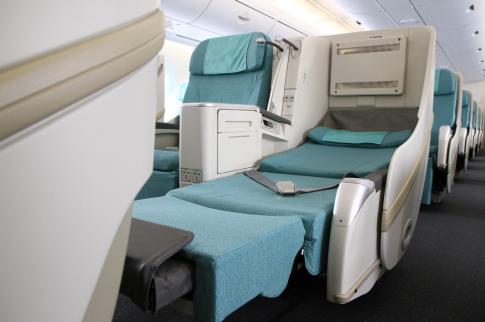The future of business class

JetBlue's move is the latest in the battle between airlines to design the most appealing, most comfortable business- and first-class seating arrangements.
by N.B. | WASHINGTON, D.C.
JETBLUE, an American discount airline, announced at the Global Business Travel Association conference last week that it would introduce lie-flat seats and even "private suites" in its "premium" class in the second quarter of 2014. The seats will be available on San Francisco-New York and Los Angeles-New York flights. JetBlue is reconfiguring the front of the Airbus A321s that service those routes to accommodate the new 2-1-2 premium-class seat layout. (The "1" in the 2-1-2 layout is the so-called "private suite," in which each traveller would have no immediate neighbours.)
JetBlue's move is the latest in the battle between airlines to design the most appealing, most comfortable business- and first-class seating arrangements. As a fascinating New York Times article detailed earlier this month, seat and seating layout design is one of the few engineering concerns that most airlines keep in-house. That has led to an "arms race" among carriers:
“
Billions are being spent on research and development, architects, industrial designers and even yacht designers to pack seats with engineering innovations and fancy features. Just fabricating a single business-class seat can cost up to $80,000; custom-made first-class models run $250,000 to $500,000...
... Lufthansa, Europe’s largest airline and the world’s fourth largest in terms of passengers, is investing $4 billion to improve its cabins, offer satellite-based Internet and upgrade its onboard entertainment system. But the new business-class seat, which first appeared last year on the company’s new Boeing 747-8 planes, is perhaps the boldest attempt to lure the high-value passenger. The seat research, design, manufacture and installation accounts for roughly a third of that $4 billion investment, [says Björn Bosler, the airline’s manager for passenger experience design, business and premium].... Eleven planes are now outfitted with the new seats, and Lufthansa is expected to install about 7,000 of them on 100 wide-body airplanes by 2015.”
All this action in the front of the plane doesn't necessarily trickle down to those who fly in economy. JetBlue long operated as a single-class airline, and because of that, its economy cabin offered a lot of leg room. Some, including Harold Meyerson of the Washington Post, see darker forces at work. "The upgrading of business and the downgrading of coach present a fairly faithful mirror of what’s happening in the larger economy: the disappearance of the middle class," Mr Meyerson wrote recently, noting JetBlue's move away from single-classing, Lufthansa's fancy new seats, and Spirit Airlines' spirit-sapping economy offerings.
It's not always the case that adding more premium seats will make an airline's normal offerings worse—it all depends on how many seats the airline tries to cram into the rest of the plane. If an airline reduces the number of economy seats, it can maintain the same level of service there while adding premium seats. But that means packing fewer people onto each flight (and maybe charging more for economy). JetBlue, thankfully, will continue to offer better economy-class legroom than its competitors. But that legroom will be reduced by one inch per row in order to make more room in the front of the plane—one small step towards the Emirates-in-the-front/Spirit-in-the-back aeroplane of the future. Perhaps there's something to Mr Meyerson's metaphor after all./economist




 del.icio.us
del.icio.us Digg
Digg

Post your comment